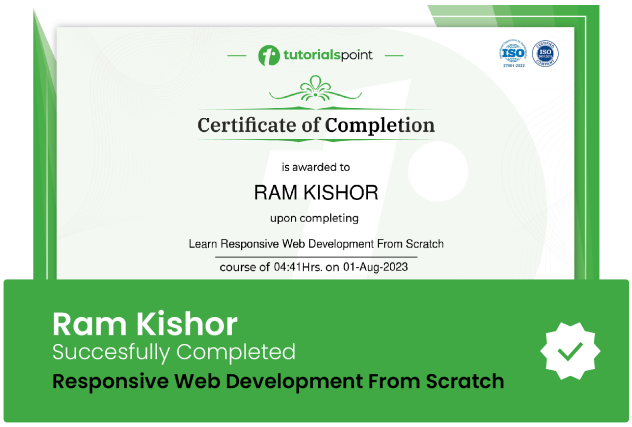VPC Solutions with EC2 for Production: AWS with Terraform
Learn Terraform with AWS, infrastructure-as-code! Develop Scalable, Highly-Available Architecture with an AWS Architect!
Lectures -53
Resources -1
Duration -4 hours

30-days Money-Back Guarantee
Get your team access to 10000+ top Tutorials Point courses anytime, anywhere.
Course Description
Learn to implement production-ready infrastructure with AWS and Terraform today with an AWS Certified Solutions Architect!
Do you want to implement your complete infrastructure as code? Do you want to learn the coolest and most popular infrastructure configuration management tool on the market, Terraform and make a huge contribution to your skillset?
Then this course is what you need! You will not only learn how to implement Terraform code but also implement an AWS Well-Architected Framework recommended deployment model which will be Highly-Available, Scalable, Fault-Tolerant and Resilient!
In this course, we will start by exploring the tools we need throughout the course. Just to note here too, we will need an IDE with a proper Terraform plugin available. An AWS account is also necessary so I will show you how to get one if you do not already have it. Sure we will set up our environment variables for Terraform deployments and also configure our IDE to use Terraform efficiently by installing a Terraform Plugin which will highlight the syntax and auto-complete everything we intend to do.
In between all these, I will also give you a crash course on Terraform where you will gain all the information you need to implement this infrastructure!
Once we have everything set up, now is time to get our hands dirty and write some Terraform code to implement our cool, shiny architecture!
We will start off with implementing our remote state and obtaining a key pair which we will use to connect to the instances we will launch. Once we get these done, we will first create the Virtual Private Cloud (VPC) environment. To meet the demands of high-availability, we will spread our private and public subnets to three different availability zones inside a region. We will also create our Private and Public Route Tables to manage the routing between our resources inside VPC.
We’ll also make sure to attach an Internet Gateway (IGW) to our VPC to use with public subnets so the resources in those will be able to access and receive public internet traffic. Our private subnet also need some form of internet connection but not both ways; we want only internet access for outgoing connections from our resources in private subnets! To satisfy this requirement, we will launch and attach a NAT Gateway to our private route table.
After configuring the low-level networking infrastructure, we will proceed to implement our Launch Configurations for both public and private EC2 instances we will launch through Auto-Scaling Groups. Once we implement the instance launching configurations, we will move on to implement our Auto-Scaling Groups using these launch configurations. We will configure the subnets, machine images, startup scripts and simply everything we need to launch instances successfully.
Auto-Scaling doesn’t come out of the box; we will need to configure it regarding our demands and how we want to scale our instances. For our implementation, we will use Target Tracking Scaling which will help use scale and manage our EC2 instances all by itself; we don’t have to do a single thing!
We do not do anything for Auto-Scaling once we set it up but for sure we want to know what’s going on with our instances. That’s why we will create a SNS Topic and subscribe to it to get real-time notifications on what’s happening with our instances and infrastructure.
There are much more to come in this course and I cannot wait for you to come and learn the best practices from an AWS Certified Solutions Architect!
Goals
What will you learn in this course:
- You'll learn how to code against AWS using Terraform!
- You'll learn the AWS Well-Architected Framework Best-Practices while implementing!
- You'll learn how to isolate and control your own infrastructure with Terraform using Route Tables, Internet Gateways, Security Groups and Rules!
- You'll learn how to launch Highly-Available, Scalable, Fault-Tolerant and Resilient EC2 Instances on AWS using Terraform!
- You'll have very good understanding of VPC concepts like Subnets, Route Tables and Internet Gateways by putting all into real-world practice with Terraform code!
- You'll be confident to work with AWS using Terraform for any kind of AWS Resource on VPC and EC2 Instances!
- You'll learn how to read and code against an Terraform HCL language!
- You'll be able to launch your own infrastructure on AWS without even signing-in to AWS!
Prerequisites
What are the prerequisites for this course?
- An AWS Account - Free Tier Available!
- General Knowledge on AWS Model would be nice
- Theoretical Knowledge on VPC and EC2 Concepts would be nice but not necessary!
- Any IDE or even a text-editor, recommend with a Terraform Plugin

Curriculum
Check out the detailed breakdown of what’s inside the course
Introduction
5 Lectures
-
Source Code
-
Introduction 01:14 01:14
-
About This Course 02:50 02:50
-
What We Will Build in This Course 04:36 04:36
-
What Do You Need For This Course 02:14 02:14
Preparing The Environment for Development
5 Lectures

Windows Environment Setup
3 Lectures

MacOS Environment Setup
3 Lectures

Terraform Refresher
1 Lectures

Virtual Private Cloud (VPC) Network Infrastructure with Terraform - Part 1
7 Lectures

Virtual Private Cloud (VPC) Network Infrastructure with Terraform - Part 2
7 Lectures

Elastic Compute Cloud (EC2) with Terraform - Part 1
8 Lectures

EC2 High Availability, Scalability and Fault Tolerance with Terraform
12 Lectures

Wrapping Up
1 Lectures

Instructor Details

Niyazi Erdogan
eCourse Certificate
Use your certificate to make a career change or to advance in your current career.

Our students work
with the Best


































Related Video Courses
View MoreAnnual Membership
Become a valued member of Tutorials Point and enjoy unlimited access to our vast library of top-rated Video Courses
Subscribe now
Online Certifications
Master prominent technologies at full length and become a valued certified professional.
Explore Now


 Updated on Apr, 2024
Updated on Apr, 2024
 Language - English
Language - English
